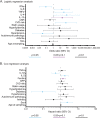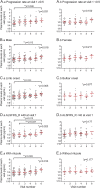Systemic inflammatory response and neuromuscular involvement in amyotrophic lateral sclerosis
- PMID: 27308305
- PMCID: PMC4897985
- DOI: 10.1212/NXI.0000000000000244
Systemic inflammatory response and neuromuscular involvement in amyotrophic lateral sclerosis
Abstract
Objective: To evaluate the combined blood expression of neuromuscular and inflammatory biomarkers as predictors of disease progression and prognosis in amyotrophic lateral sclerosis (ALS).
Methods: Logistic regression adjusted for markers of the systemic inflammatory state and principal component analysis were carried out on plasma levels of creatine kinase (CK), ferritin, and 11 cytokines measured in 95 patients with ALS and 88 healthy controls. Levels of circulating biomarkers were used to study survival by Cox regression analysis and correlated with disease progression and neurofilament light chain (NfL) levels available from a previous study. Cytokines expression was also tested in blood samples longitudinally collected for up to 4 years from 59 patients with ALS.
Results: Significantly higher levels of CK, ferritin, tumor necrosis factor (TNF)-α, and interleukin (IL)-1β, IL-2, IL-8, IL-12p70, IL-4, IL-5, IL-10, and IL-13 and lower levels of interferon (IFN)-γ were found in plasma samples from patients with ALS compared to controls. IL-6, TNF-α, and IFN-γ were the most highly regulated markers when all explanatory variables were jointly analyzed. High ferritin and IL-2 levels were predictors of poor survival. IL-5 levels were positively correlated with CK, as was TNF-α with NfL. IL-6 was strongly associated with CRP levels and was the only marker showing increasing expression towards end-stage disease in the longitudinal analysis.
Conclusions: Neuromuscular pathology in ALS involves the systemic regulation of inflammatory markers mostly active on T-cell immune responses. Disease stratification based on the prognostic value of circulating inflammatory markers could improve clinical trials design in ALS.
Figures



References
-
- Bruijn L, Cudkowicz M. Opportunities for improving therapy development in ALS. Amyotroph Lateral Scler Frontotemporal Degener 2014;15:169–173. - PubMed
-
- Sta M, Sylva-Steenland RM, Casula M, et al. . Innate and adaptive immunity in amyotrophic lateral sclerosis: evidence of complement activation. Neurobiol Dis 2011;42:211–220. - PubMed
-
- Keizman D, Rogowski O, Berliner S, et al. . Low-grade systemic inflammation in patients with amyotrophic lateral sclerosis. Acta Neurol Scand 2009;119:383–389. - PubMed
Grants and funding
- MC_UU_12019/1/MRC_/Medical Research Council/United Kingdom
- MR/M008606/1/MRC_/Medical Research Council/United Kingdom
- MALASPINA/APR13/817-791/MNDA_/Motor Neurone Disease Association/United Kingdom
- FRATTA/JAN15/946-795/MNDA_/Motor Neurone Disease Association/United Kingdom
- MALASPINA/APR08/RF/6039/MNDA_/Motor Neurone Disease Association/United Kingdom
LinkOut - more resources
Full Text Sources
Other Literature Sources
Research Materials
Miscellaneous
